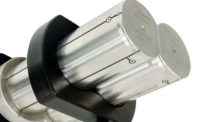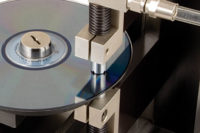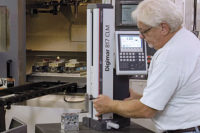
Air gaging was the breakthrough measuring technology of the 1940s and 1950s. Introduced decades before electronic gaging was widely accepted, it provided the first high performance-50 microinch or better-gaging on the shop floor. Today, air gaging is just as important and actually growing in popularity. There are many reasons for this, including speed, ease of use, high-precision results even under the toughest shop conditions and gages that can last for years measuring literally millions of parts.
But probably the most important reason air gaging will continue to be a key measuring method comes down to the air jet itself-the small orifice through which air creates the physical conditions for a measurement. It is hard to imagine that a small hole, approximately 0.050 inch in diameter, could be so important, yet there are no other gaging sensors as small, or that can be placed so close together to measure multiple diameters or geometric forms. Small electronic or eddy current type sensors may approach the size of an air jet, but nothing can match either its cost or ability to work in a wet and oily shop environment, right at the point of manufacture.
Air gaging is not the solution for all shop measurements. It is typically used for applications where the tolerance is fairly tight-usually less than ±0.001 inch-and the surfaces have less than a 50 microinch Ra. However, when these precision conditions exist, air can be the best solution for a wide range of applications.

An air jet is more than just a small hole. It is really a precision hole created with many knowns-its size; a controlled surface around the jet; a known depth from the surface of the tool holding it; and a built-in air escape system. Source: Mahr Federal Inc.
How it works
An air gage works on the principle of back pressure which occurs when pressurized air from the jet is restricted by a solid surface. Think of the way a garden hose reacts when the nozzle is pressed against a wall. The distance of the wall from the escaping water jet affects the flow of water through the hose: as the nozzle gets closer, the flow will be reduced and pressure in the hose will build. You surely have done this “experiment” yourself, probably when washing your car, and seen the spray seem to increase as you bring the hose closer to the car’s surface-the same thing happens with an air gaging system.Most of today’s air gaging systems use this pressure phenomenon as the method for measuring distance. Of course an air jet is more than just a small hole. It is really a precision hole created with many knowns: its size; a controlled surface around the jet; a known depth from the surface of the tool holding it; and a built-in air escape system. To create the actual measuring system, physics requires the obstruction (the thing being measured) be located close enough to actually reduce the flow of air. When this restriction takes place, a pressure-distance curve is created. This pressure-distance curve is very linear over a portion of its range and is very repeatable. It becomes the principle upon which most air gage systems work.

When airflow is restricted, a pressure-distance curve is created. This pressure-distance curve is linear over a portion of its range and is repeatable. Source: Mahr Federal Inc.
Using a Small Hole as a Sensor
Once it is known that a precision hole can create a physical phenomenon and can be translated into a dimension, a way to verify that it is working properly and a means to apply it is needed. By far the most common use of an air gage is to measure the diameter of a precision hole. Manufacturers have probably seen air plugs for measuring diameters lying around the shop and thought of them as pretty simple tools. However, there is really a lot of precision involved in the manufacture of the plug, and there are specific things to inspect to ensure that one is getting the most from the tool. When manufacturers make air tooling, they inspect it for balance, zero location and centralizing error.In an air plug there are usually two air jets acting as a differential system. A steel cylinder (the air plug) is used to position the jets 180 degrees apart to create a diameter measurement. The beauty of a differential system for measuring diameter is that the diameter can be measured without regard to the location of the gage within the part. To accomplish this, the sensors have to be matched and work alike. Because each air jet is creating its own pressure distance curve, each one should be checked for performance.

To check for balance error, position the air plug so that the jets are vertical (pointing up and down). Place a master on the plug and let the master hang on the tool so that it is resting right over the top jet. Adjust the air gage display to zero. Now lift the master so that it rests against the bottom jet and restricts it to its maximum. The air gage display should not change. Source: Mahr Federal Inc.
Knowing that the air jet is working in the center of the pressure-distance curve also is important. This is the most linear part of the pressure-distance curve and comprises the most usable range of the air sensor. Check this by determining the zero position of the gage. On a fixed magnification air gaging system this is fairly easy. Manufacturers can provide a set of pneumatic masters that simulate both extremes of the pressure-distance curve and its mid-point. These restrictors allow the technician to verify that both the air gage display and the tooling are performing as designed. Place the zero master restrictor on the air gage display and adjust it to read zero. Now replace it with the tooling to be checked and its zero master. Without adjusting the air display, read the value-it should be nearly identical to the restrictor value. Large deviations-greater than 10% of range-signify damage to the jets and need for repair.

Perform the centralizing error test in the same manner as the balance check and move the master up and down on the plug observing the display. Large deviations mean the plug clearance has become worn and it may be time to replace. Source: Mahr Federal Inc.
Testing for centralizing error is similar to balance error except the jets are tested in the horizontal position. Perform the test in the same manner as the balance test and move the master up and down on the plug observing the display. Large deviations mean the plug clearance has become worn and it may be time to replace. Depending on the plug design characteristics, the centralizing error should certainly be below 10% of part tolerance.

Figure 1. Source: Mahr Federal Inc.
Results You Can See
With this small sensor there is the means to measure more than simple inside and outside diameters. Because the jets are about 0.050 inch in diameter, they have the flexibility to be placed close to one another, or combined at specific locations for multiple diameters and to provide the capability to measure various geometric conditions.It is no secret that a combination of electronic sensors, or coordinate measuring machines (CMMs) with touch probes can measure diameter, squareness, straightness, center distance, bend or twist, or any geometric condition of a part. But what is unique about the air jet is that it can be built into a precision tool that can be used to measure these conditions at the point of manufacture, and in one fast measurement with little operator involvement.
The chart in Figure 1 shows many of the types of relational checks that a combination of air jets can perform. In some cases, the air jets can be combined pneumatically to perform the measurement, as is the case with an air plug. But each jet also can be combined in an external processor to measure diameters, tapers, bend and twist from the same jets.
The chart also shows some typical examples of the use of air jetting to perform dimensional or geometric measurements. Let’s take a look at some to demonstrate the versatility of this small sensor:

Measuring diameters on a diesel cylinder liner sleeve would seem like a fairly easy task. But when an operator needs to check multiple diameters, compare them for cylindrical form and do it in a limited time, air gaging becomes a viable solution. Source: Mahr Federal Inc.
To inspect the part for diameter variation and estimate cylindricity based on multiple levels of diameters, the part is rotated 180 degrees. Based on the use of multiple diameters being measured at multiple locations, a complete inspection of the cylinder liner can be done in less then 8 seconds. To do this with touch probing on a CMM could take close to 30 minutes-and likely would not have the same precision. When manufacturing thousands of pieces, saving minutes is critical for part throughput.
Now take the same concept, but instead of a straight cylinder, think of a tapered part, less than 0.5 inch in diameter. Now one can start to see the advantage of the small air jet. No other shop floor system can get three pairs of jets in such a small diameter and provide the performance of the air system.

It would be nice if all measurements were simple IDs or ODs, but they are not. Here the air gage creates a matching part and the air jets are not on the diameter but on the chord. Source: Mahr Federal Inc.
It's All in the Jets
Think about it-sensors that are 0.050 inch or smaller, that can be placed within 0.10 inch of each other, and be combined to produce any number of dimensional and geometric results-something that has been around for more than 50 years but still offers the type of measurement solutions on the shop floor. Some things do get better with age-air gaging is one of them.QQuality Online
For more information on air gaging and how it has been used through the years, visit www.qualitymag.com to read these articles:- “Why Air Gaging Still Matters”
- “Quality Innovations: Air Gage Does Double Duty”
- “Use Air to Improve Measurements”


